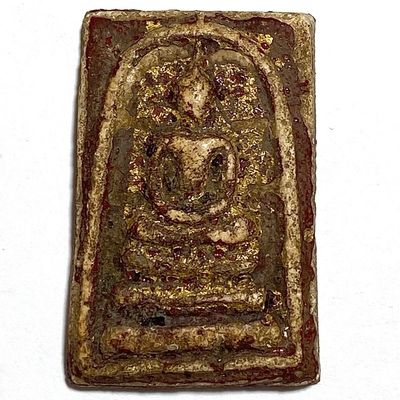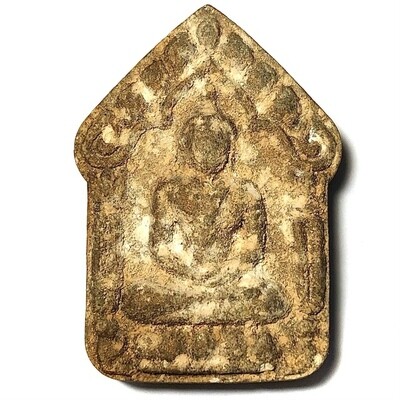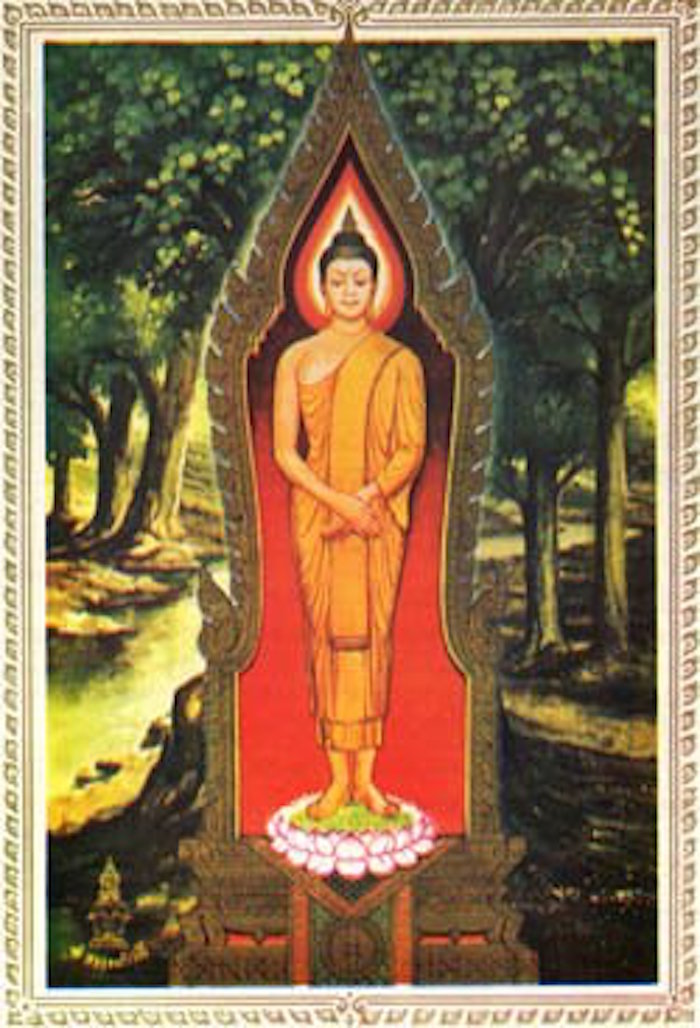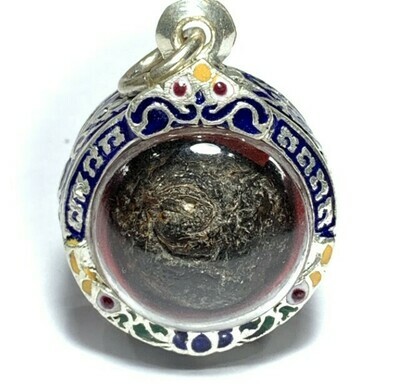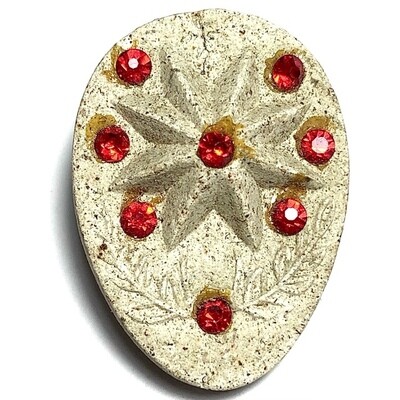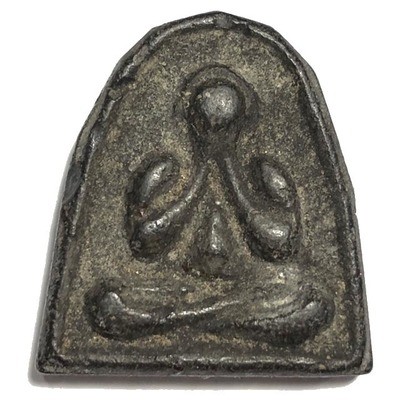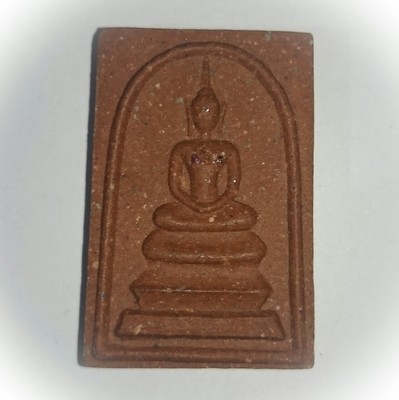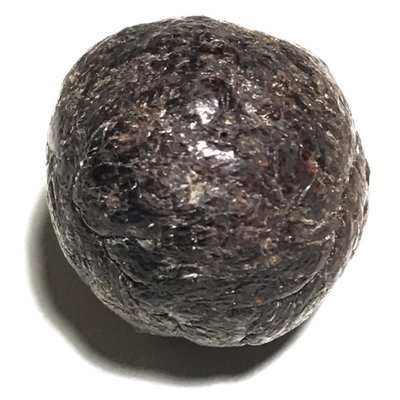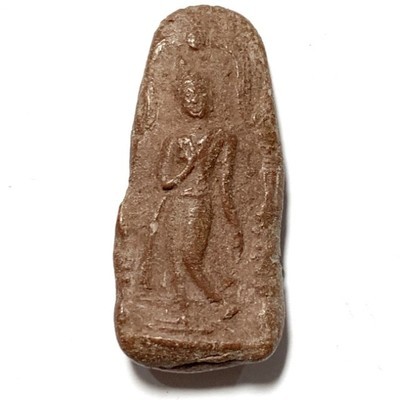Presenting a tiny but powerful and rare classic amulet from one of the Great Khao Or Masters of the 20th Century, Rian Glom Lek Hlang Chedi 2505 BE Nuea Tong Daeng Miniature Guru Monk Coin Por Tan Klai Wajasit
This Sacred amulet of the Great Khao Or Master of Nakorn Sri Tammarat, Master of Wat San Khan and Wat Pratat Noi, is a very rare amulet from Por Tan Klai’s 2505 BE Blessing Ceremony Edition, and is considered a ‘Jaek mae Krua’ type amulet (meaning ‘give to the kitchen maids and temple helpers’), which is suitable not only for men, but due to its miniature size, a perfect amulet for ladies or children to wear.

Rian Glom Lek 2505 BE Por Tan Klai Wajasit Wat Suan Khan
The 2505 BE edition of amulets of Por Tan Klai, is a highly preferred edition, which saw his famous ‘Rian Glom’ round Monk coin amulet with Chakra released, The Rian Glom Lek Hlang Chedi, and the Roop Tai Por Tan Klai Guru Monk Blesséd Photographamulets such as look om chan hmak and ya sen tobacco balls, and sacred powder amulets of various models.
A very rare and highly prized amulet for the devotees of Por Tan Klai to associate with his image and pray to him with a blessed image of the Guru, and the Chedi Relic Stupa on rear face for Buddhanussati and Marananussati. A powerful and Sacred amulet which has passed through the hands of the Guru and been blessed by him.
Por Tan Klai was one of the Top Guru Master Monks of the Last Century, and is considered one of the Four Great Masters of the Previous Generation of Lineage Masters of the Khao Or Southern Sorcery Lineage.
Kata Bucha Por Tan Klai
Pra Pim Um Badtr Pim Lek Wednesday Buddha - Luang Phu Poo Wat Intraviharn Circa 2450 BE
Pra Pim Um Badtr (Standing Buddha with Mendicant Almsbowl) by Luang Phu Poo (2373 BE - 2476 BE) - Wat Intra Viharn (Wat Bang Khun Prohm Nork). A Top Level Masterclass Amulet which is extremely rare to find, and carries price that is relative to its status in the Pra Niyom Masterclass Category
Luang Phu Poo was one of the 10 Master Gaeji Ajarn Guru Monks to enter into the Dtamra Pra Somdej of Somdej Pra Poottajarn (Dto) Prohmrangsri for the adherence to the same Wicha of Muan Sarn Sacred Powder making as found in the contents of the Pra Somdej Wat Rakang Kositaram of Somdej Pra Poottajarn (Dto) Prohmrangsri. A Classic Ancient Amulet of Master Class Status and Legendary Proportion.
Luang Phu Poo was most famous for his Pra Somdej Sae Yid Khaen Hak Sork amulet, which was notable for the 'broken elbows' style of the curve of the Buddhas arms, sitting on a multi tiered dais. His most highly prized amulets go for well over five to ten thousand dollars, and one would be lucky to find any authentic amulet of his making under a thousand dollars, in any place at all in the present day.
A most attractive and in pristine condition Ancient Amulet from one of the Grand Masters of Pra Somdej and a Grand Adept of the Sacred Muan Sarn powder making of the Dtamra Somdej Pra Poottajarn (Dto) Prohmrangsri.

The Amulet features a standing Buddha holding the bowl of the Mendicant (Almsbowl), with a highly defined grooved arch around him (sum). The details and relief on this particular exhibit are enviably clear and highly refined when gazing at the depth and contrast of the amulet.

It is indeed a rare example for its clear detail and absence of serious wear and tear for an amulet of its age and pedigree, and can be hence considered an extremely desirable exhibit to have in one's possession, both for wearing and visual appreciation under the eye loupe when under study, as well as a dead certainty in competition shows, for prizewinning.

The Pra Pim Um Badtr was made in three different sizes (Yai/Large, Klang/Medium and Lek/Small). depicts the Buddha holding an Almsbowl.

Once the Sermon was over, the King (Buddha's father), was filled with spiritual bliss (Piti) and raised his hands in reverence to his Enlightened Son, the Buddha. All the citizens of Kapilavatthu followed his lead and raised their hands. His Father made the supposition that because the Buddha was his Son, and used to live there with him in the Palace, that the Buddha would surely come to eat at the palace. So he neglected to invite him to come, thinking that it should be taken for granted. He ordered fine foods to be prepared and laid out in the palace, but when he saw that the Buddha did not appear, he made his second ignorant mistake, supposing that the Buddha must have gone to bring all the other Bhikkhus (monks) to eat too.
He thus ordered the servants to prepare a great banquet with food and gifts for the Monks. When the Buddha and his "sawaka" (disciples) still did not appear, the King then contemplated the story of Buddha's previous lives, considering what Buddha had done in those lifetimes, and realised that the Buddha would always take alms on the roadside without any conceit, despit the fact he was a Prince and could eat in his Father's palace. The Buddha indeed walked along the roadsides of the City to beg for alms, and this was the first time ever that the Folk of Kapilavatthu were able to make offerings to the great Bodhisattva Sakyamuni, and see him in his Radiance. This incident is thus the reason for the creation of Buddha statues , standing holding the almsbowl, and is called "Pra Puttaroop Um Badtr" (Buddha holding almsbowl).
This is the Pim Lek small model measuring 3.5 x 1.8 Cm, and is an absolutely beautiful example of one of Luang Phu Poo's most famous Classic amulets.

This amulet is not only an esteemed Pra Niyom amulet of High Value and Master-Class Category in itself, most certainly worthy of standing an excellent chance of first prize in any National Competition, but is an Ongk Kroo Reference Study Amulet for those who wish to perfect their visual ability to view and recognise the Pra Somdej amulets of Somdej Pra Poottajarn (Dto) Prohmrangsri of Wat Rakang Kositaram.

Above; Old Catalog Publication of the Encyclopedia of the amulets in the Dtamra of Luang Phu Poo.

The reason for this is that the Powder amulets of Luang Phu Poo contain precisely the same formula of the five special powders (Pong Wised Ha Chanid) used by Somdej Pra Poottajarn (Dto) Prohmrangsri in the making of the Pra Somdej Wat Rakang Masterpiece. 'Ongk Kroo' means 'Teacher Amulet' and means that one can use it as a reference model for comparison of authentic amulets from the same Dtamra.

To own an amulet such as this, is to enter into the ranks of the Master-Class Collectors, and one can stand proudly in any community of collectors with one of these around your neck. Most certainly worthy and recommend-ably encased in solid gold casing, to do justice to an amulet that stands in the top ranks of Thai Buddhist Ancient Amulet Collection.

Luang Phu Poo was Abbot of Wat bang Khun Prohm (Nork) so famoous for the Wat Bang Khun Prohm Pra Somdej of Somdej Pra Poottajarn (Dto) Prohmrangsri - Wat Intra Viharn is one fo two temples within the same enclave which both are classed under the category of Wat Bang Khun Prohm.

Luang Phu Poo is one of the most eminent Abbots of this Temple's History and stands in the Lineage History of the Dtamra Pra Somdej along with 9 other esteemed masters. One of the Top Ten respected Pra Somdej Amulet creators of all Thai History.


Above; Luang Phu Poo - Wat Intra Viharn
Below; Famous Pra Somdej of Luang Phu Phu of the Master-Class High End Category of Sacred Ancient Amulets. Only affordable to the Serious Collector who has the Seriosity to Invest. These are Highly Sought after by Wealthy Thai Devotees and High End Collectors.



Above; Pra Somdej Khaen Sork Hak Luang Phu Poo
Kata for Wednesday Buddha (Daytime)
Sappaasiwachaadtiinang Nippamandtaatakang Wiyayannaasedti Wisangko Rang Sesanjaabpi Bparissayang Aanagkhedtamhi Sappadt-ta Sappataa Sappabpaaninang Sappaso Bpi Niwaare Dti Bparidtan Dtampanaamase

